The Future of Food ~ Native Bees
by Guest blogger: Dave Hunter
of Crown Bees
Listen to his podcast HERE
We know there are huge differences in how pollen is carried by the European honey bee and our native bees. Relatively unknown, people are surprised to learn that hole-nesting native bees like our mason and leafcutter bees are actually much better pollinators than honey bees.
Research shows that mason bees can significantly increase the yield of cherries, apples, pears, almonds, strawberries, and blueberries. Field observation trials with leafcutter bees produce more beans, squash, alfalfa seed, sweet potatoes, and seed crops. Yet few farmers are aware of native bees they can raise themselves to increase yields.
How Bees Carry Pollen
Pollen carried by a bee from one flower to another creates a seed, a fruit, or a vegetable. All bees feed their larvae a mix of pollen and nectar as a source of protein.
Let’s first understand the needs of a honey bee hive. The honey bee queen lays about 1,000+ eggs per day and these developing bees require large amounts of pollen and nectar. Honey bees are driven to gather and bring home every grain of pollen and they coordinate gathering from food sources with a “waggle dance” that can focus their efforts on a single source, removing all available pollen. Worker honey bees must forage up to 5 miles away and they evolved to carry pollen sticky on their hind legs so that little falls off on the long flight home. Honey bees are very clean, focused, and sophisticated pollen gatherers.
Honey bees focus on a pollen source across long distances
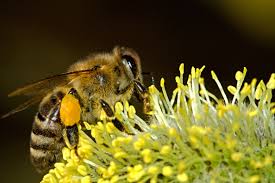
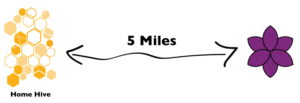
On the other hand, the needs of most native bees are different than social bees. Most native bee species are solitary bees who are single mothers doing all of the chores to raise their young. Each solitary female bee is fertile and only lays up to about 35 eggs over their short 4-6 week adult lifespan. For efficiency, solitary bees only fly a few hundred feet from their nests and they keep the pollen messy and dry on their hairy legs or bellies. Dry pollen falls off easily with each flower visit. Working alone, solitary bees are not coordinated like honey bees and each independent bee meanders to gather their pollen. Solitary hole-nesting bees are messy, unfocused, and excellent local pollen spreaders.
Solitary hole-nesting bees meander between pollen sources across short distances
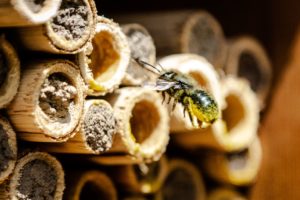

Why Raise Hole-nesting Bees
Out of the world’s 20,000 bee species, about 25% nest in above-ground holes ranging in size from 3-10mm in diameter. Most hole-nesting bees nest in holes that are pre-made and they don’t cause structural damage. It’s extremely difficult to safely move the remaining 75% of bee species that nest in the ground to a nearby farm.
Hole-nesting bees can be easily moved from a yard to a local farm. Native bees should remain in their natural range to reduce the spread of disease and pests. Native bees are easier to raise than non-native bees because they are better acclimated to their local weather conditions.
Solitary Bee Life Cycle
Solitary hole-nesting bees do not fly year-round, instead each species flies primarily during the spring or summer season. Most solitary bees have a short adult lifespan of about 4-6 weeks. Working from the back of her nesting hole forward, the mother bee gathers pollen and nectar into a pollen loaf, lays a single egg, and seals the nesting chamber. Hole-nesting bees can use a variety of natural nesting materials to protect each chamber, like clayey mud, resin, chewed up vegetation, cactus pulp, or downy fuzz from plants.
Spring bees typically hibernate over winter as adult bees that are ready to start flying as soon as spring arrives. The new generation of spring bees will begin to spin a cocoon by early summer and then develop into an adult bee by the fall. Many springtime bees only produce one generation per year.

Spring mason bee larvae consuming pollen and nectar known as bee bread.
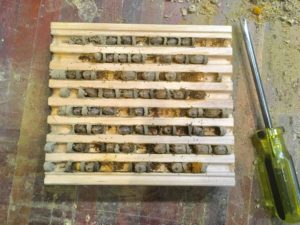
Spring mason bee cocoons in wood nesting trays during fall harvest
Summer bees typically hibernate as larvae and need the early summer heat to develop into an adult bee, this is called incubation. Summertime bees can produce multiple generations per summer season. Some of the new generation of bees hatch and develop into adults right away, returning to build a new nest in the same summer they were laid. Eggs laid late in the season will hibernate as larvae.
What Hole-nesting Bees Need
Hole-nesting bee species come in a variety of sizes and are looking for nesting holes that are just the right diameter for their species. You can provide nesting holes between 3-10mm in diameter.

Pollinator pack for bees, with varying size holes
Each hole-nesting bee is looking for pollen and nectar within a 300’ or 100m radius from their bee house. Each female bee can visit 2,000 open blooms a day, so plant plenty of flowers nearby. Honey bees can fly through toxic environments but we find that native solitary bees will avoid nesting near treated lawns. If you must spray, avoid application while your native bees are actively nesting.
In the wild, nesting holes are naturally spread across the landscape. Unfortunately, man-made nesting holes are close together and can be attractive to diseases and pests. To get rid of bee pests and diseases, open the nesting holes and harvest the cocoons. Harvesting cocoons is when you open the filled nesting holes and leave pests and disease behind. It’s an easy and quick task and you can learn how from our videos. Nesting holes that are easy to open are paper tubes, natural lake reeds, or wood trays. Bamboo and drilled blocks of wood are dangerous to open and become bee cemeteries quickly due to pests spreading in unopened nesting holes.
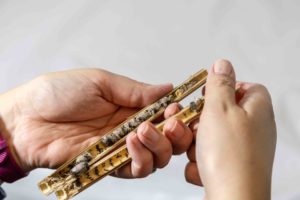
Harvesting mason bee cocoons from a lake-bed reed
The Native Bee Network
Out of the roughly 1,000 hole-nesting native bee species of North America, only one – the blue orchard mason bee is raised. Where are the rest?
Crown Bees launched a visionary program in 2018 to find the optimal hole-nesting bees and wasps in the various ecoregions learn about them, raise them, and rehabilitate them.
Click HERE to see map of Ecoregions of Canada, United States, and Mexico
Our first phase, Discover, is a nationwide citizen science program. We continue to enlist thousands of gardens, conservation reserves, right of ways, and campuses to find local native hole-nesting bees. We need thousands of nesting sites set up in each county.
Participants enter their data via a web app a few times a year and data is tracked for each nesting site’s unique program number. Observations are made when each participant removes the nesting house for winter storage.
The data collected will be freely available to researchers and will be used to determine the optimal bees for phase two, Analysis. Phase three will propagate the optimal species and we’ll finish with phase four, Rehabilitation with bees placed into wild spaces, yards, and farms for a sustainable future.
We also expect to find beneficial solitary hole-nesting wasps that prey on soft or hard-sided insects. We hope to support Integrated Pest Management programs rather than rely upon man-made chemicals.
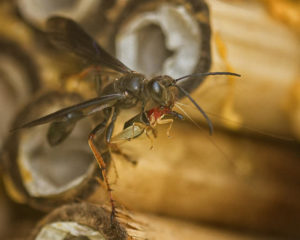
Grass-carrying wasp with prey. Courtesy of bugguide.net.
Learn more about this program here: Crown Bees Programs
What You Can Do
- Increase your farm and garden yields by raising pollen-spreading native bees.
- Purchase bees and supplies or set up a healthy bee hotel.
- Think about bees’ needs from their perspective!
- Participate in Native Bee Network. We’d love to have your help.
UrbanFarm.org/nativebees
About this author:
 Dave is the founder and owner of Crown Bees, a native bee company in Woodinville, WA that sells bees and products online, to nurseries and farmers. His experience with mason bees extends over two decades. Dave founded the commercial mason bee industry, Orchard Bee Association, and works with researchers to ensure that what Crown Bees practices is both ethical for the bee and efficient for the farmer/gardener. He co-authored the book The Mason Bee Revolution, and speaks to gardeners, farmers, and researchers throughout the year
Dave is the founder and owner of Crown Bees, a native bee company in Woodinville, WA that sells bees and products online, to nurseries and farmers. His experience with mason bees extends over two decades. Dave founded the commercial mason bee industry, Orchard Bee Association, and works with researchers to ensure that what Crown Bees practices is both ethical for the bee and efficient for the farmer/gardener. He co-authored the book The Mason Bee Revolution, and speaks to gardeners, farmers, and researchers throughout the year
How to reach Dave:
Website: CrownBees.com
Email: info@crownbees.com
Phone: 425-949-7954
*Disclosure:
Some of the links in our podcast show notes and blog posts are affiliate links and if you go through them to make a purchase, we will earn a nominal commission at no cost to you. We offer links to items recommended by our podcast guests and guest writers as a service to our audience and these items are not selected because of the commission we receive from your purchases. We know the decision is yours, and whether you decide to buy something is completely up to you.



I am very interested in adding native bees to my orchard and garden.
Excellent article. J’aime bien souvent votre blog